Contents
The internal structure of the chicken coop directly affects the health and productivity of the bird, so the interior of the bird apartments, perches in the chicken coop and nests for laying hens should first of all be comfortable for the inhabitants, and only then be beautifully designed or practical to clean.

Why is it important to choose the right perch option?
Despite the many different tales about the closeness and primitiveness of the chicken, in fact, the bird is distinguished by a very subtle instinct, observation, shyness and intelligence. Everything that scares or excites, sooner or later will affect productivity and health. Therefore, they try to build the interior and nests with their own hands, subject to at least three conditions:
- The room should not have extraneous odors, a lot of light or other irritants. If they stop cleaning the litter in the chicken coop, the chickens instantly start to get sick;
- Inside the chicken coop, it is necessary to make a normal influx of fresh air, while there should be warm, sunny areas, and separately cold shaded areas;
- The location of the perch and nests for chickens indoors is chosen in such a way that everyone who enters the chicken coop moves only along the resting places or nest boxes.
Any movement “to the front” or along the shortest distance to the resting place is perceived by the bird as an attack, and is ready to run away or change its position at the first opportunity. Therefore, the nests in the chicken coop, if possible, try to make them closed, and remove them from the front door and direct sunlight to the maximum distance.
An exception may be grown up young animals, which, due to their curious nature, can ignore the fear of invading their territory. Such birds do not need perching poles, they can spend the night anywhere and any way.
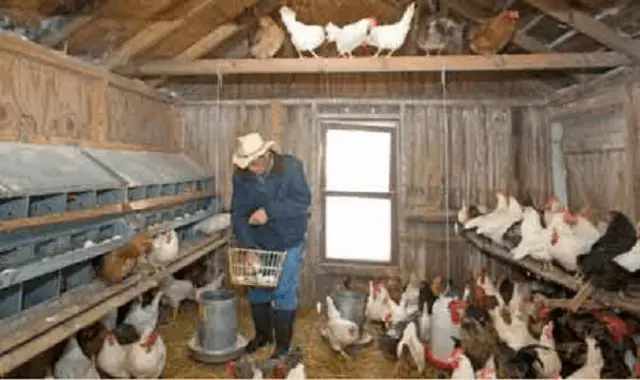
How to make perches and nests really comfortable
After building a chicken coop, the first thing you need to do is divide the interior of the premises into several sectors:
- Feeding and drinking area;
- Half of the room is allocated for the arrangement of a perch and a place to spend the night;
- At least a quarter is given for nests for laying hens;
- A separate, isolated block is allocated for sick and quarantine birds.
The size of each compartment of the chicken coop is determined depending on the total livestock and the number of layers. In a properly built chicken coop, the bird practically does not get sick. One nest is usually shared by two or three birds. With the arrangement of perches, the situation is more complicated, since in chicken society, as in any flock, there is its own division into groups, most often by age.
Arrangement of a perch for chickens
A perch is a series of horizontal planks or poles fixed to walls, stands, or simply knocked into one frame structure using ordinary nails. Relatively recently, lattice or mesh perches, fixed on wooden boxes for collecting litter, began to be used, photo.

It is difficult to judge how comfortable the grids are for resting, but the fact that the grid is not the most convenient design for chicken paws is obvious.
The best option for arranging a place to spend the night and rest for a chicken would be ordinary poles 4-6 cm in diameter, not necessarily even and smooth, most importantly – durable, and with soft wood. In rural chicken coops, with rare exceptions, ordinary slabs of pine, walnut or fruit trees are used to equip the perch. No one uses commercial wood blocks, even after rounding the surface, the grip for chicken feet remains uncomfortable.
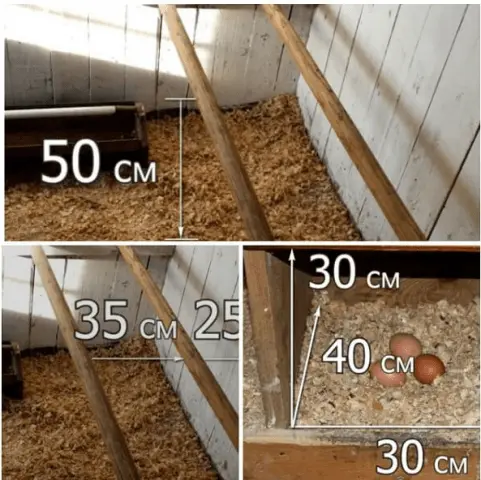
Perch poles must be long enough, at least 1,5-2 m, and strong, to support the weight of at least 10 chickens, with a total weight of up to 35 kg. In addition, a properly fixed pole should not “play” or rotate. The perch is assembled from three or four tiers, the lower one is closest to the aisle and is set at a height of 35-40 cm above the floor. The second and third rows are raised by 30-35 cm.

For laying hens, you can install a couple of additional rails with your own hands, making it easier for young and older birds to jump and move along the perch. For heavy and lazy broilers, it is imperative to make a ladder, and the poles themselves are lowered by 15-20 cm. The design of the perch in the chicken coop must be done so that resting chickens do not block the approach to nests and feeding places.
How to make perches in a chicken coop, their height and size, is usually chosen based on the number of birds so that there is no crowding when feeding. The height of the ceilings in the chicken coop depends on the height of the perch, usually they try to make sure that at least 70 cm remain from the ceiling to the upper pole.
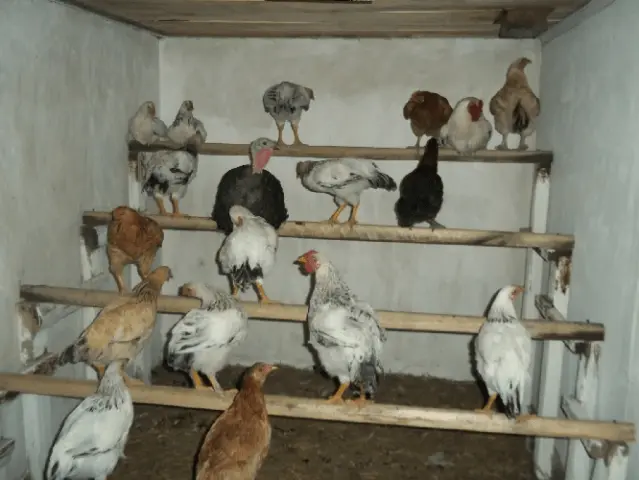
Due to the thick feather cover, birds always have problems with heat transfer and self-regulation. Saves only a small draft, blowing through the chicken coop. Therefore, on the opposite wall from the entrance to the chicken coop, it is necessary to make a barred ventilation window with your own hands, 15×20 cm in size.
The vent should be positioned so that a straight line from the coop entrance to the vent runs under the perch. In this case, the flow of incoming air will enable the birds to survive the hot summer at the height of the perch, without digging holes in the ground. In addition, the optimal location of the perches relative to the entrance dries the room well with air flow and removes odors.
The door at the entrance to the chicken coop needs to be made double. To the usual plank sash, they additionally hang a frame half the size of the door leaf with their own hands. The sash can be made with your own hands from an ordinary rail and tightened with a metal mesh.
To simplify the cleaning of the chicken coop, you can install a plastic or tin pan for cleaning the litter under the perch. The intake is best made from a galvanized corrugated sheet with a wave height of 15 mm. The sides of the pallet on three sides can be bent and strengthened with your own hands using a wooden lath so that the sheet does not bend during cleaning and carrying. After cleaning, the cleaned surface is sprinkled with a thin layer of sand and clay.
At the entrance to the chicken coop, next to the perch, they put a feeder and drinkers. For 5 hens, one feeder and two drinkers are enough; for a larger number of birds, two feeding places must be made, 100-150 cm apart. In addition to the grain feeder, you can make an additional tray for plant mass, tops, mowed grass, and separately make an ash pan next to the perch – a large trough with grated ash and sand.

A mandatory attribute of a good chicken coop is a window. Birds need sunlight like air, so it would be right to place a window opening directly opposite the perch, so that at noon a maximum of sun penetrates into the chicken coop.
Laying nest arrangement
Before you make nests, you need to find the best place to install them. Usually a row of several nests is transferred to the opposite side of the perch. Thus, the birds entering the coop can equally freely go to the nests or go to the roost.
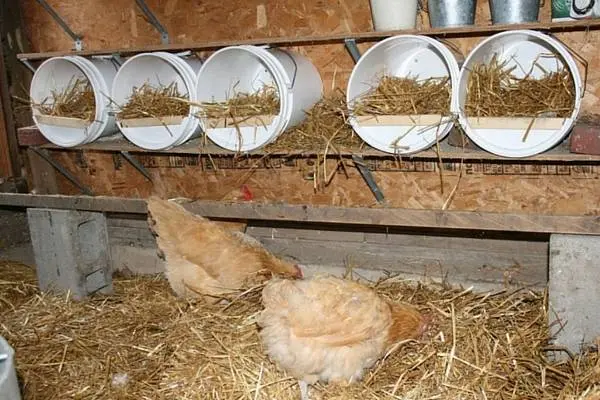
In addition, you will need to make several options for the chicken nest and determine which one the birds like best. No matter how strange it may sound, but beautiful, built according to the recommendations of poultry farmers or bought ready-made nests, chickens can be ignored. Therefore, when laying a chicken coop, it is necessary to make several options for a nest for chickens, and the bird will decide which one is better, and then you just need to copy the option you like. If this is not done, then there will be very few eggs in the established nests for hens, and most laying eggs will be laid in the most inappropriate places.
Sometimes poultry farmers claim that parasites, strong odors, or some unknown factors, including proximity to the perch, are the cause of this phenomenon. Of course, all nests for chickens should be made as accessible as possible, the litter should be periodically cleaned and updated with carefully dried grass and straw.
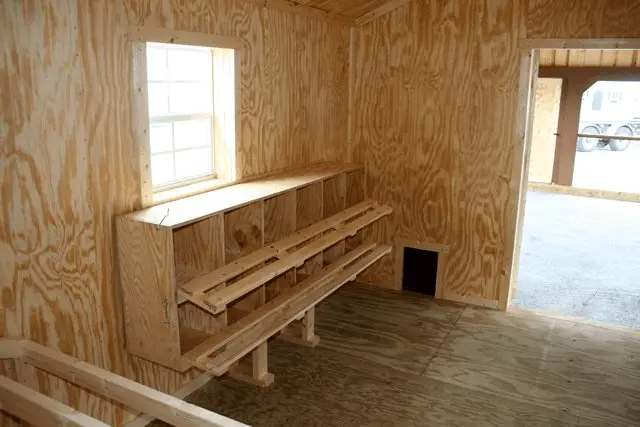
Chicken nest designs can be very different. The easiest way is to make a nest in the form of an open box with side sides, 20 cm high and a front side of 5-7 cm, without a roof. The main condition is that the nest should be removed from the perch, located at a low height and not in contact with other nests. This will make the egg laying process as safe as possible.
Sometimes they try to make nests in the form of a large box, with a roof and a central entrance, in the likeness of a birdhouse. Even for winter, this is not the best nest option. A warm nest is best made in the form of one long box, divided by partitions. The relatively close arrangement will allow the layers to warm up faster, and the presence of partitions will keep the eggs laid from damage. The nest box can be made portable so that it can be moved and installed closer to the heater if necessary.

In addition, the nest must be made so that the sunlight entering the coop does not fall on the hens, otherwise the bird, “sealed” in the box, can get heat stroke. The chicken is extremely curious by nature, so it is important to make the space around the hens as free as possible so that the bird can see the entrance to the coop and the perch poles. Having the opportunity to observe the behavior of relatives, the chicken quickly calms down.
Conclusion
Many nuances and details of arranging a chicken coop, perch, nests become clear only after a dozen years of breeding birds. The experience gained allows you to make the life of a chicken calmer and more satisfying, which always turns into a hundredfold in the form of eggs and meat. Problems most often arise when from 5-10 hens go to keeping a tribe of 50-100 heads. And even for such quantities, you can make a normal chicken coop and perch, if you correctly understand the behavior and reaction of the bird.









